Meet the Prospects: Wide Receivers and Tight Ends
Whether it's a wide receiver or tight end, having a pass catcher who can create mismatches on the field can dramatically expand a team's offense.
By the same token, having a physically imposing target like a Calvin Johnson or Jimmy Graham can help a quarterback turn a bad play into a good one. How many times have you seen Drew Brees or Matthew Stafford on the verge of being sacked, only to chuck it up to their star pass-catcher - even with that player blanketed in coverage?
Players like Johnson and Graham come down with the football more times than not, leaving defensive backs frustrated and searching for answers. The draft features a handful of players that fall into that category, and landing one of them could help any NFL team light up the scoreboard for seasons to come.
In this year's first round there could be as many as six receivers taken in the opening round, and likely a pair of tight ends as well. With the NFL enjoying a love affair with the forward pass, the running backs' loss is the receivers' gain.
Here is a look at the top tight ends and receivers leading up to the draft.
Tight Ends
5. C.J. Fiedorowicz, Iowa
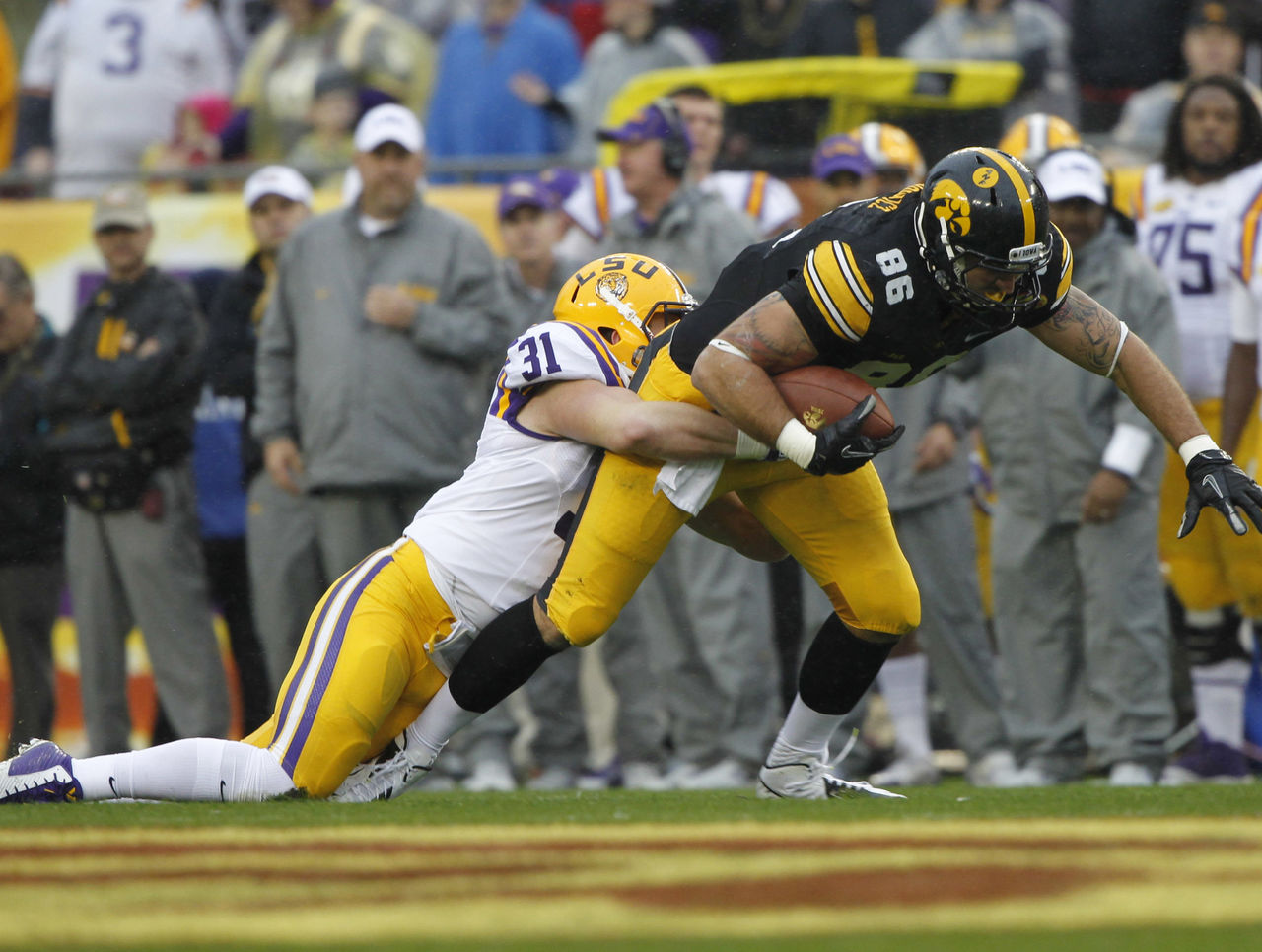
Measurables
- 6'5"
- 265 lbs.
- 4.76 speed
Strengths
Fiedorowicz is a big target that knows how to get open. He uses his size to his advantage and creates space between himself and defenders.
He has big hands and avoids making body catches. Fiedorowicz can be split out wide if needed and moved around on the line of scrimmage.
He embraces physicality and looks for contact after catching the football. Fiedorowicz does a good job sealing off defensive ends in run blocking situations.
Weaknesses
Fiedorowicz isn't fast and won't be able to run away from some linebackers at the next level. He will provide minimal production after the catch and will need to be used mainly in red-zone situations.
Some have questioned his work ethic and say he needs to be motivated.
NFL player comparison: Joseph Fauria
Ideal fit: Houston Texans
The Texans ranked 28th in red-zone efficiency last season and bringing in Fiedorowicz would take some of the pressure off Garrett Graham in those situations. Houston figures to start a rookie quarterback at some point next season and tight ends can often be a security blanket for young signal callers.
4. Troy Niklas, Notre Dame
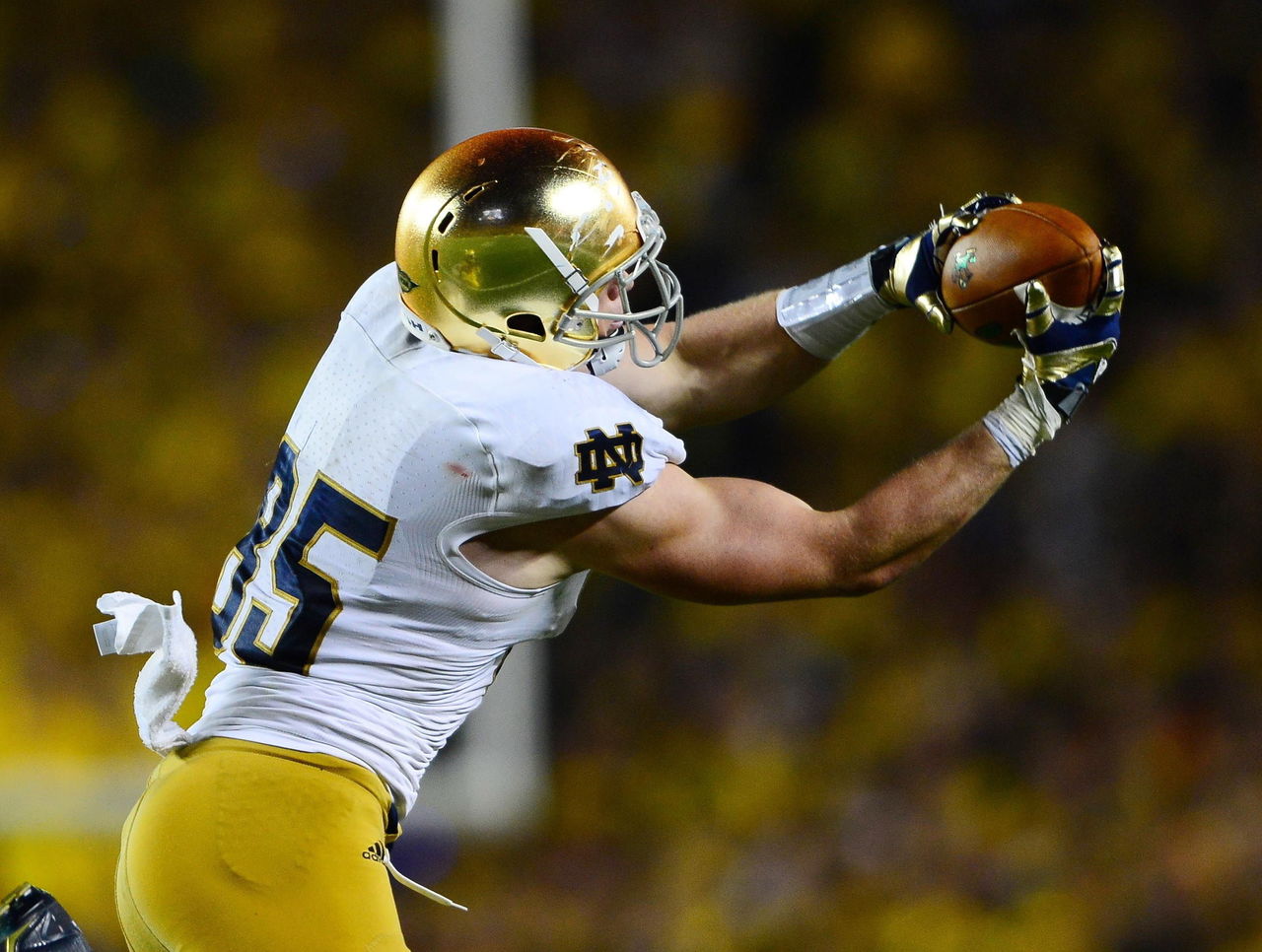
Measurables
- 6'6"
- 270 lbs.
- 27 bench press reps
Strengths
Niklas gets in and out of his breaks well and can run the majority of the route tree. Notre Dame lined him up all over the field, including employing him in pass protection and using him out of the back field on occasion.
He's a good blocker and locks onto defenders, driving them up field in the run game.
Niklas is a strong leaper and, given his 6-foot-6 frame, will have no trouble out-jumping linebackers and defensive backs in the red zone.
Weaknesses
Niklas doesn't possess elite speed and can't stretch the defense vertically. His work after the catch is limited and he lacks vision with the ball in his hands to elude tackles.
NFL player comparison: Kyle Rudolph
Ideal fit: Buffalo Bills
The Bills re-signed Scott Chandler in the offseason, but he ranked 41st among tight ends in 2013, according to Pro Football Focus. Niklas may be available as late as the third round and he would give the Bills another target for second-year quarterback EJ Manuel to gel with.
3. Austin Seferian-Jenkins, Washington

Measurables
- 6'5"
- 262 lbs.
- 20 bench press reps
Strengths
Seferian-Jenkins is a big body that comes down with balls in traffic. He controls his frame well when leaping for the football and is a major factor in the red zone.
He drags would-be tacklers down the field after the catch and is difficult to bring down with just one man. He uses his strength in run blocking and can handle defensive ends at the point of attack.
Seferian-Jenkins shows good awareness by breaking off his pattern when his quarterback is forced to scramble, and works back to the football well.
Weaknesses
Seferian-Jenkins doesn't exhibit great speed coming off the line of scrimmage and isn't your typical seam-threat tight end.
His cuts on sharp breaking routes aren't fluid and he doesn't change directions as quickly as most scouts want to see.
NFL player comparison: Heath Miller
Ideal fit: Kansas City Chiefs
The Chiefs had a difficult time getting production from the tight end spot last year, thanks in large part to an injury to Anthony Fasano. Seferian-Jenkins would be an upgrade over even a healthy Fasano and would give Alex Smith someone to build chemistry with, much like he did with Vernon Davis in San Francisco. Seferian-Jenkins is likely going to be gone in the second round, so if the Chiefs want him they are going to have to trade up, since they don't hold a pick there in this year's draft.
2. Jace Amaro, Texas Tech

Measurables
- 6'5"
- 265 lbs.
- 4.74 speed
Strengths
After catching just 32 passes in his first two seasons at Texas Tech, Amaro exploded in his junior year for 106 receptions and more than 1,300 yards.
Amaro is a big target that runs the seam route very well, which should make him an attractive commodity in a pro-style offense. He can also flex out and line up in the slot. He runs with ease for his size.
He's a physical runner after the catch and is tough to bring down thanks to his ability to break tackles.
Weaknesses
Amaro isn't an efficient blocker and will likely need to be used in specific passing packages when he debuts this fall.
He also plays too upright at times and can get re-routed on his release from the line of scrimmage.
NFL player comparison: Marcedes Lewis
Ideal fit: Green Bay Packers
With Jermichael Finley unlikey to re-sign with the team after coming off a severe neck injury, Amaro could fill the void with a late first-round pick. His pass-catching skills would be maximized by Aaron Rodgers and the Packers, and he would give them an additional passing weapon now that James Jones has left for Oakland.
1. Eric Ebron, North Carolina
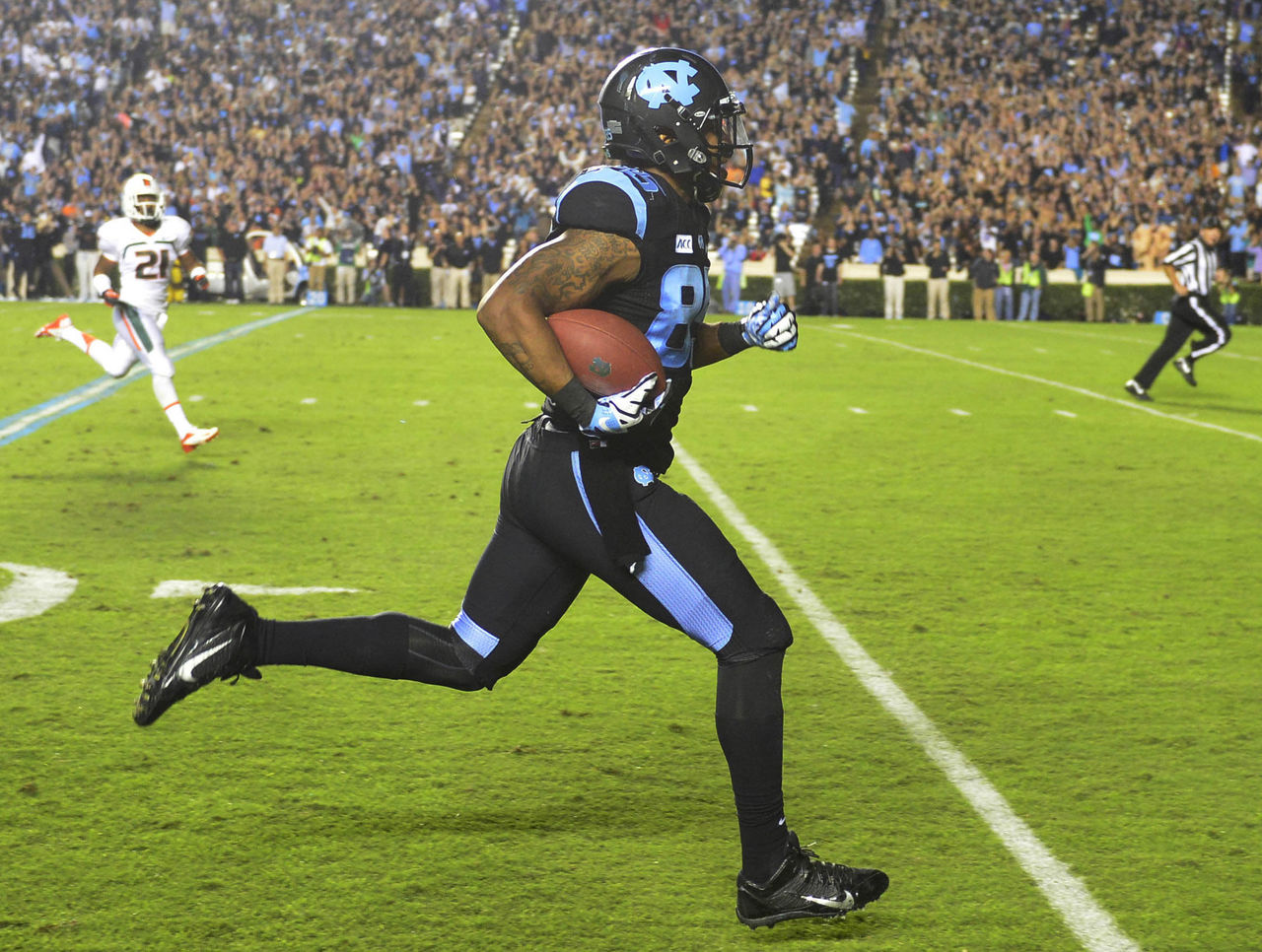
Measurables
- 6'4"
- 250 lbs.
- 4.60 speed
Strengths
Ebron releases cleanly off the line of scrimmage and gets into his route quickly. He's fast enough to line up in the slot and can even be flexed out wide.
Ebron is a big target with a large catching radius and can compensate for errant throws that aren't right on point. He has big play capability and can turn short gains into huge ones with his smooth running after the catch.
He can stretch the defense and is too much to handle for a linebacker. Ebron can easily out-jump defensive backs because of his length and he averaged more than 16 yards per catch in his career at North Carolina, while posting nearly 1,000 yards in 2013.
Weaknesses
The main knock on Ebron is as a blocker. It's not something he does particularly well and he could be over-matched trying to move NFL linemen off the line of scrimmage. He needs to improve his technique.
Ebron doesn't make dropped balls a habit, but he did have a handful in college when he lost concentration.
NFL player comparison: Kellen Winslow Jr.
Ideal fit: New York Giants
Ebron is a top-15 pick and the Giants may opt to use their 12th selection on him. They got minimal production from Brandon Myers last season and let him walk. If the season started today, Adrien Robinson and his three career appearances would be first up on the depth chart, which would be a tenuous situation at best. New York has been using a patchwork tight end unit since Jeremy Shockey (save for one year of Martellus Bennett) and it's finally time for an upgrade.
Wide Receivers
10. Allen Robinson, Penn State

Measurables
- 6'2"
- 220 lbs.
- 4.60 speed
Strengths
Robinson ran a pro-style offense under Bill O'Brien at Penn State, which will make him attractive to NFL teams. He led the Big Ten in receiving in each of the last two seasons.
Robinson is a quarterback-friendly receiver, working back to the ball well when his signal-caller gets in trouble. He moves well in and out of breaks and knows how to exploit zone coverage.
He plays a physical style and isn't afraid to sell out to make a play on the football.
Weaknesses
Robinson lacks the speed needed to separate from pro corners, as his 4.60 40-time at the combine suggests. He has a habit of making body catches as opposed to attacking the ball in the air with his hands.
Robinson also missed the opening half of Penn State's first game in 2013 because of a disciplinary issue.
NFL player comparison: Michael Floyd
Ideal fit: New England Patriots
The Patriots struggled to stay healthy at receiver last season and Aaron Dobson and Kenbrell Thompkins were inconsistent. Danny Amendola and Rob Gronkowski have struggled to stay on the field because of injuries, so adding another weapon to Tom Brady's repertoire will likely come in handy at some point in 2014. Robinson should hear his name called late in the second round.
9. Davante Adams, Fresno State

Measurables
- 6'1"
- 212 lbs.
- 4.56 speed
Strengths
Adams' numbers were scary good in two seasons at Fresno State, as he put up 233 catches and more than 3,000 yards.
He's a good leaper that runs the fade route well and regularly wins in jump ball situations. Adams is a strong route runner and gets production from patterns over the middle and to the outside.
He runs hard after the catch and breaks tackles from defenders on a consistent basis.
Weaknesses
Adams' numbers were inflated based on the system he was in at Fresno State. He was the benefactor of many high-percentage throws from Derek Carr in a spread offense.
He doesn't have great speed and will need to make the majority of his catches running laterally as opposed to vertically in the NFL.
Adams can get careless with the football, evidenced by his three lost fumbles last year.
NFL player comparison: Keenan Allen
Ideal fit: Arizona Cardinals
The Cardinals lost Andre Roberts and picked up Ted Ginn in free agency, but Ginn is more of a return man than a reliable receiving option. Adams, who projects as a second-round pick, would give the Cards a nice option behind Larry Fitzgerald and Michael Floyd for Carson Palmer. Arizona sits in a division with three strong defenses against the pass, so adding offensive weapons is key.
8. Cody Latimer, Indiana

Measurables
- 6'2" lbs.
- 215 lbs.
- 23 bench press reps
Strengths
Latimer's athleticism has him flying up some draft boards. His impressive pro day and combine even have a few believing he could be a first-round selection.
Latimer's strength is what stands out the most in his game. He benched 23 reps at the combine, which led all receivers, and he puts it into practice by escaping jams at the line of scrimmage, as well as blocking down field.
Although not a true burner, Latimer is agile and makes good cuts, allowing him to pick up yardage after the catch.
Weaknesses
Latimer lacks true foot speed to go with his strength and has difficulty breaking away from corners.
He can be prone to drops and looking to turn up the field before securing the catch.
NFL player comparison: Andre Johnson
Ideal fit: Jacksonville Jaguars
Some have Latimer sneaking into the first round, but he's probably more likely to land in the late second or early third. The Jags need more weapons on offense, especially with Justin Blackmon's future being up in the air, and Latimer would give them a physical target. If Jacksonville does draft a quarterback like most expect, it would be nice to have some assets to go with him.
7. Donte Moncrief, Ole Miss
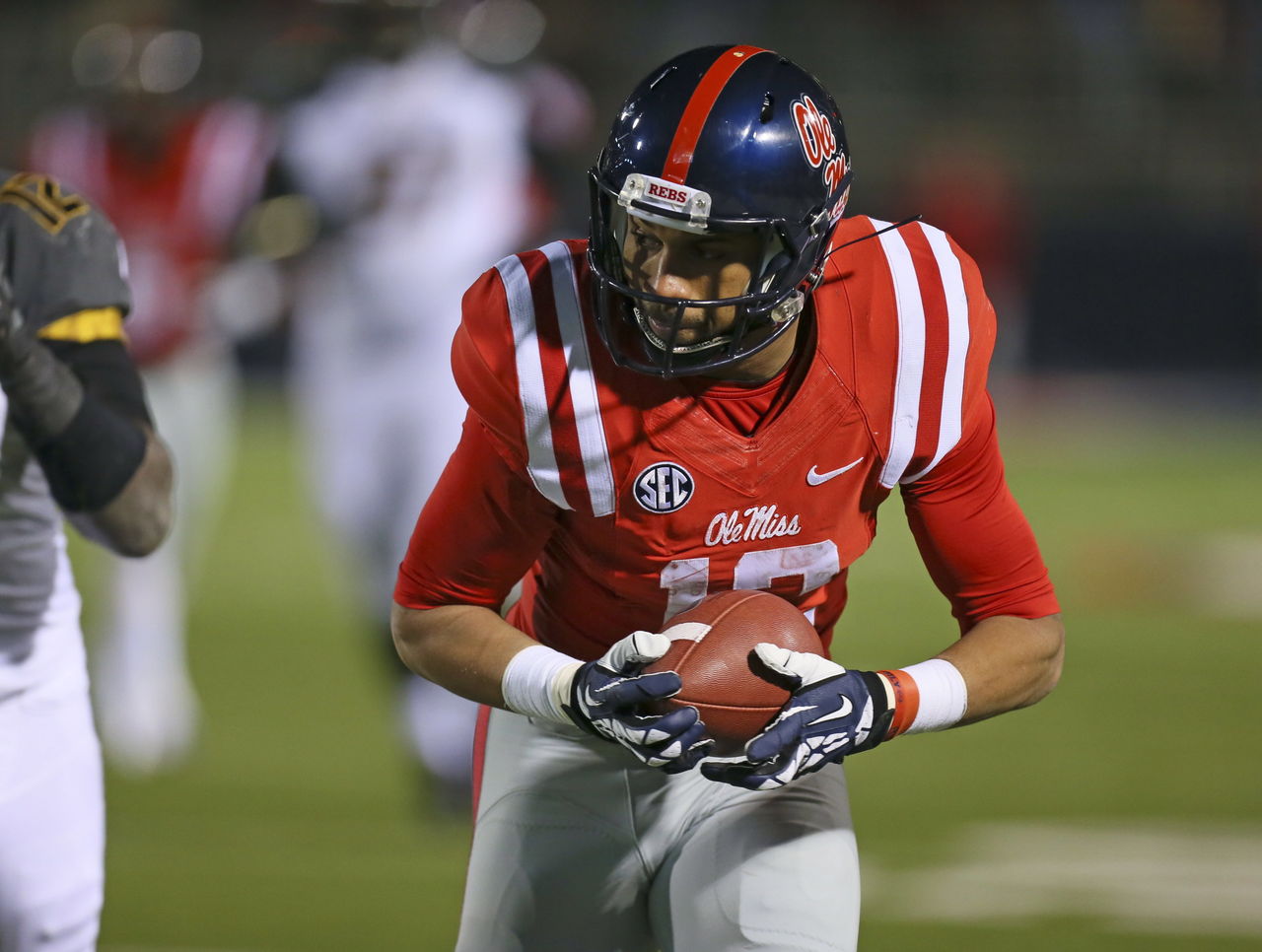
Measurables
- 6'2"
- 221 lbs.
- 4.40 speed
Strengths
Moncrief has the makings of a good possession receiver with his sure route running and ability to make catches in traffic. He uses his body well to shield defenders and gives his quarterback a good target, helping to convert in third-and-intermediate situations.
Moncrief demonstrates a knack for shaking man coverage and often fools defenders using double moves. He generates space by exploiting the cushion given to him by corners, as he's able to push them upfield by selling the go route hard before coming back to the football.
He's a good blocker in the run game and isn't afraid to get physical with defenders.
Weaknesses
Moncrief isn't a huge numbers guy and topped out at 66 catches with 979 yards in his best season at Ole Miss. He will likely struggle in a No. 1 role right away, and would be better suited going somewhere with an established receiving group.
He ran well at the combine, but speed isn't Moncrief's strength. Moving the chains is likely where he'll make his living in the NFL.
NFL player comparison: Anquan Boldin
Ideal fit: Pittsburgh Steelers
The Steelers have lost Mike Wallace and Emmanuel Sanders in consecutive offseasons, so bringing in someone like Moncrief is much needed. He would be an excellent compliment to the big play capability of Antonio Brown and an upgrade over depth acquisitions Darrius Heyward-Bey and Lance Moore. Moncrief should be available when the Steelers pick in the second round.
6. Brandin Cooks, Oregon State

Measurables
- 5'10"
- 189 lbs.
- 4.33 speed
Strengths
Cooks is a burner who clocked a 4.33 40-yard dash at the combine. In addition to his speed, he shows good footwork and is shifty in traffic, often forcing defenders to miss tackles. Cooks is dangerous after the catch thanks to his acceleration that takes him to another gear.
He won the Biletnikoff Award as the nation's top receiver in 2013 after totaling 128 catches and more than 1,700 yards.
Cooks is surprisingly durable given his size and didn't miss a game in high school or college.
Weaknesses
Cooks will have a difficult time shedding press coverage and jams because of his stature. He looks to avoid contact and get out of bounds as opposed to fighting for extra yardage.
He's effective from the slot, but playing out wide in man coverage against a strong corner will be a challenge at the next level.
NFL player comparison: Golden Tate
Ideal fit: San Francisco 49ers
The 49ers need a deep threat to better stretch the defense for Colin Kaepernick. Anquan Boldin and Michael Crabtree have struggled matching up against divisional rival Seattle, so the speed of Cooks should open up underneath routes for them to make plays. San Francisco needs to build its team to take down the Seahawks, and spending its first-round pick on Cooks helps attain that goal.
5. Marqise Lee, USC

Measurables
- 6'0"
- 192 lbs.
- 4.52 speed
Strengths
Lee is a polished route runner who uses good footwork to get defensive backs to open up and become off-balance. He works well over the middle on crossing routes and slants.
Lee shows great vision after the catch and knows how to avoid tacklers. He reads coverage well and quickly deciphers whether he's facing man or zone.
His hands are sticky and Lee uses good body control in tight areas, making difficult sideline catches. He does a good job of tracking the ball while not losing his place on the field.
Weaknesses
Lee dealt with some injuries in college and his smaller frame doesn't exactly bode well for him to avoid a similar fortune in the NFL.
His production also took a drastic decline last year. He went from a 118-catch and 1,721-yard campaign as a sophomore to just 57 receptions and less than 800 yards as a junior.
NFL player comparison: Reggie Wayne
Ideal fit: Kansas City Chiefs
Lee probably would have been a top-10 pick last year if he came out, but his fall from grace could land him with the Chiefs later in the opening round. Kansas City ranked 24th passing the football last season and Alex Smith could use some more options that would allow him to push the ball downfield. Given the upgrade the Broncos have done to their secondary in the offseason, it will be a tough task for the Chiefs compete in the AFC West without an improvement to the passing game.
4. Odell Beckham Jr., LSU
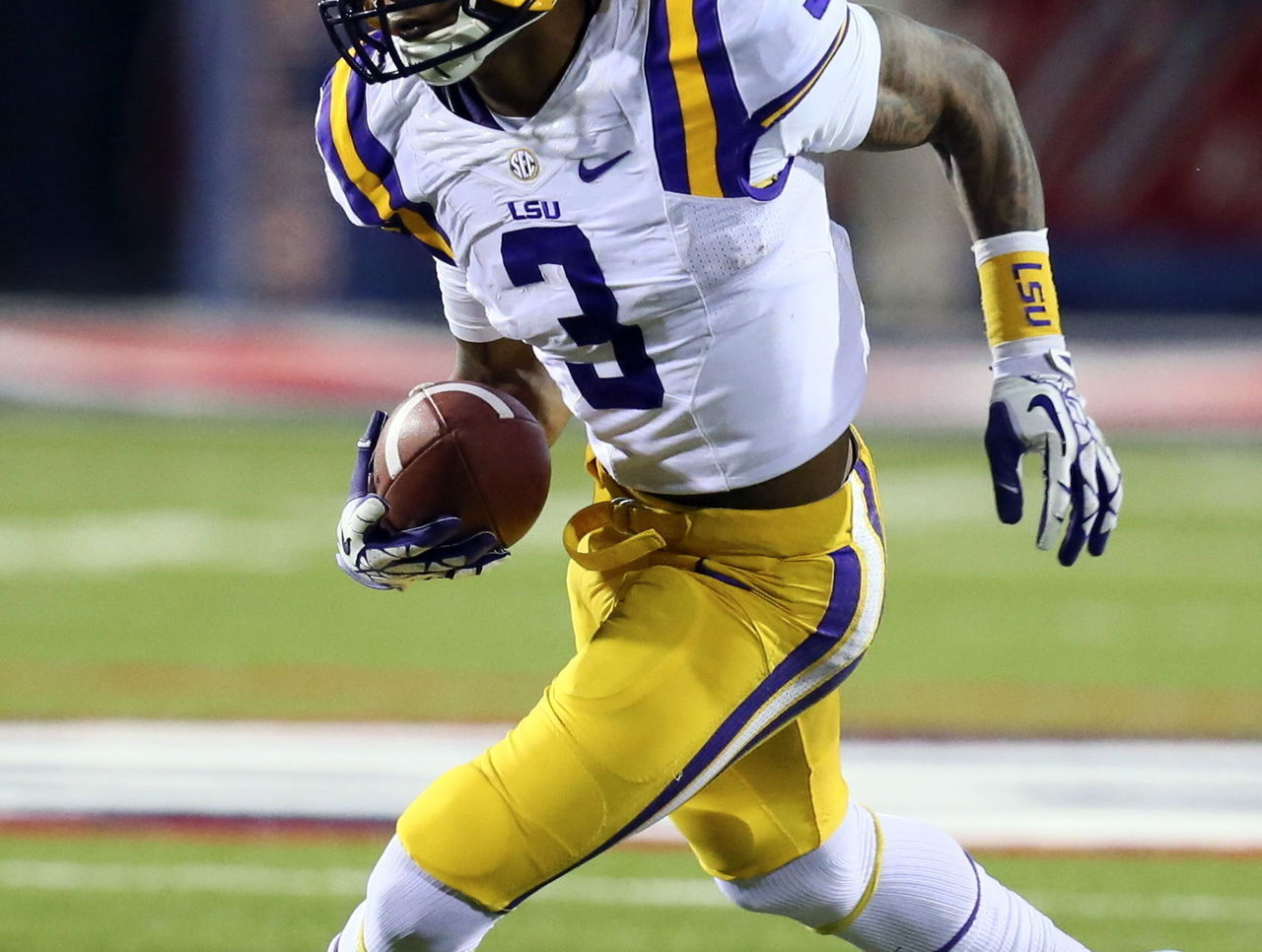
Measurables
- 5'11"
- 198 lbs.
- 4.43 speed
Strengths
Beckham Jr. has great speed and uses good moves at the line of scrimmage to shake bigger defenders in press coverage. He's a savvy route runner who is more than just a deep threat, as he'll take advantage of holes in zone coverage as well.
Despite being under six feet tall, Beckham Jr. can climb the ladder and he routinely grabs jump balls away from taller defenders. He adjusts well to throws that don't hit him in stride.
Beckham Jr. is versatile, as he can line up in the slot, out wide, and even return punts.
Weaknesses
Beckham Jr. lacks NFL size and will need to add bulk if his offense plans to have him go over the middle frequently.
Blocking isn't a strong part of his game and he struggles opening up space downfield for running backs and fellow receivers.
NFL player comparison: Victor Cruz
Ideal fit: Carolina Panthers
Beckham Jr. is a first-round pick and if he's still around when the Panthers pick at 28 they should waste little time in grabbing him. Much has been made of Carolina losing its top four receivers this offseason and they'll need someone dynamic for Cam Newton to throw to. His punt returning skills (that resulted in a pair of touchdowns at LSU) would also fill the void left by Ted Ginn's departure.
3. Kelvin Benjamin, Florida State
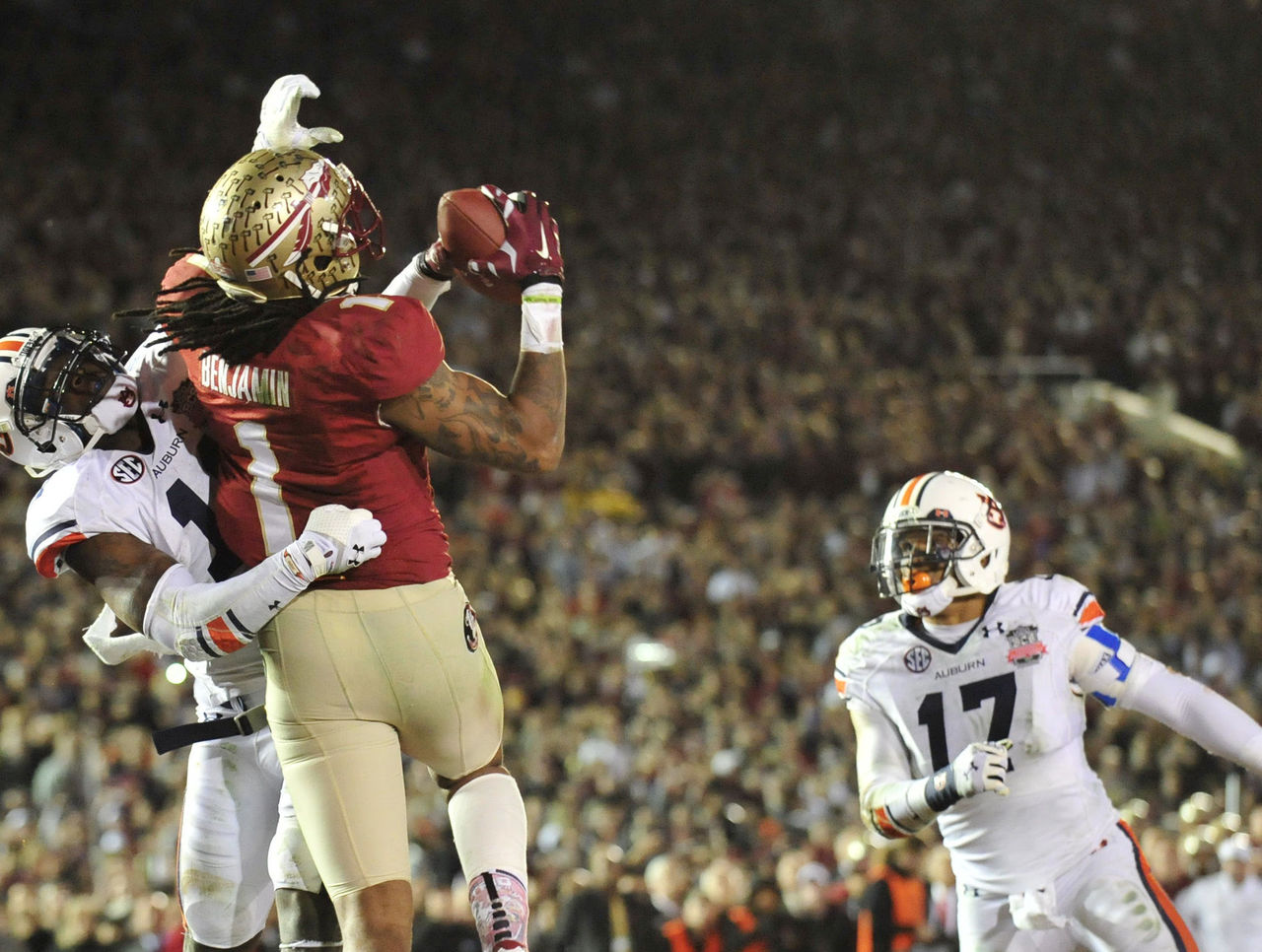
Measurables
- 6'5"
- 240 lbs.
- 4.61 speed
Strengths
Benjamin is the most physically imposing receiver in the draft and likely has the most potential. His size is close to that of a tight end and he used it to the tune of 15 touchdowns for Florida State last season.
He changes directions well for someone his size and cuts inside with ease on crossing routes or other patterns over the middle. Benjamin shows great body control and adjusts well to the ball in mid-air and will win the battle for a jump ball more often than not. He snatches the ball high and has no issue out-jumping defenders or beating double coverage.
Benjamin glides well and his long strides allows him to cover ground and create separation effortlessly.
Weaknesses
Benjamin doesn't have high-end speed and can get caught from behind when it looks like he has broken away from the pack.
Although he can be dangerous after the catch, sometimes Benjamin can start looking downfield before securing the football, leading to drops.
NFL player comparison: Plaxico Burress
Ideal fit: New York Jets
Some may feel the Jets' 18th overall pick is too high to take Benjamin, but when you are coming off a season where Jeremy Kerley led the team in receiving with 523 yards, it starts to become a little more logical. Benjamin's upside is off the charts and pairing him with Eric Decker would give Geno Smith two legitimate weapons and no more excuses.
2. Mike Evans, Texas A&M
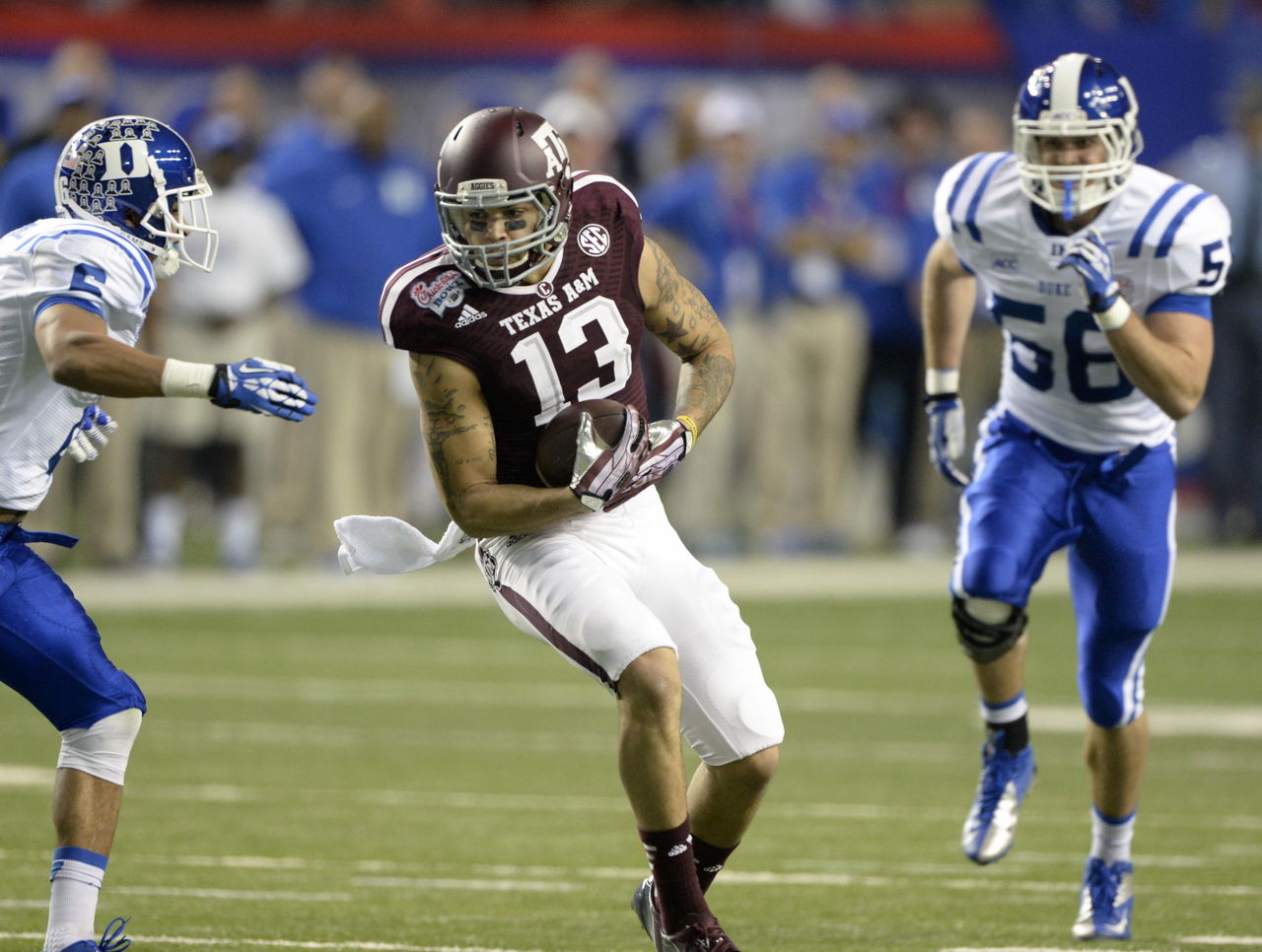
Measurables
- 6'5"
- 231 lbs.
- 4.53 speed
Strengths
Evans uses his physicality to create space between himself and pass defenders at the line of scrimmage. He has a pro body type and frame that results in catches with defensive backs hanging all over him. Once he gets the ball in his hands, it's a major undertaking to bring Evans to the turf. He doesn't shy away from defenders and often embraces contact.
Despite not having elite speed, Evans still makes big plays. He posted more than 1,100 yards in his two seasons at Texas A&M and averaged more than 20 yards per reception in 2013.
Evans will likely require double coverage in most situations at the next level and even then he is still capable of making catches in a crowd. He adjusts to the football well and snatches it at its highest point with sure hands.
Weaknesses
Evans doesn't have the foot speed to create separation from fast corners, and is going to have to rely heavily on out-muscling opponents to make plays. He doesn't change direction with ease and is better suited at running vertical routes.
Evans could stand to become more polished when running the entire route tree. He was fortunate to have Johnny Manziel scrambling around and drawing plays up in the dirt in college, but he will likely have to adapt to a more stationary pivot and conventional NFL offense.
NFL player comparison: Vincent Jackson
Ideal fit: Tampa Bay Buccaneers
The Bucs traded away Mike Williams and need a replacement. Adding Evans to pair with Jackson would give Tampa two of the biggest starting wideouts in the league. Josh McCown developed some chemistry with a target of a similar size last year in Brandon Marshall, and if he earns the starting job he could do the same with Evans.
1. Sammy Watkins, Clemson
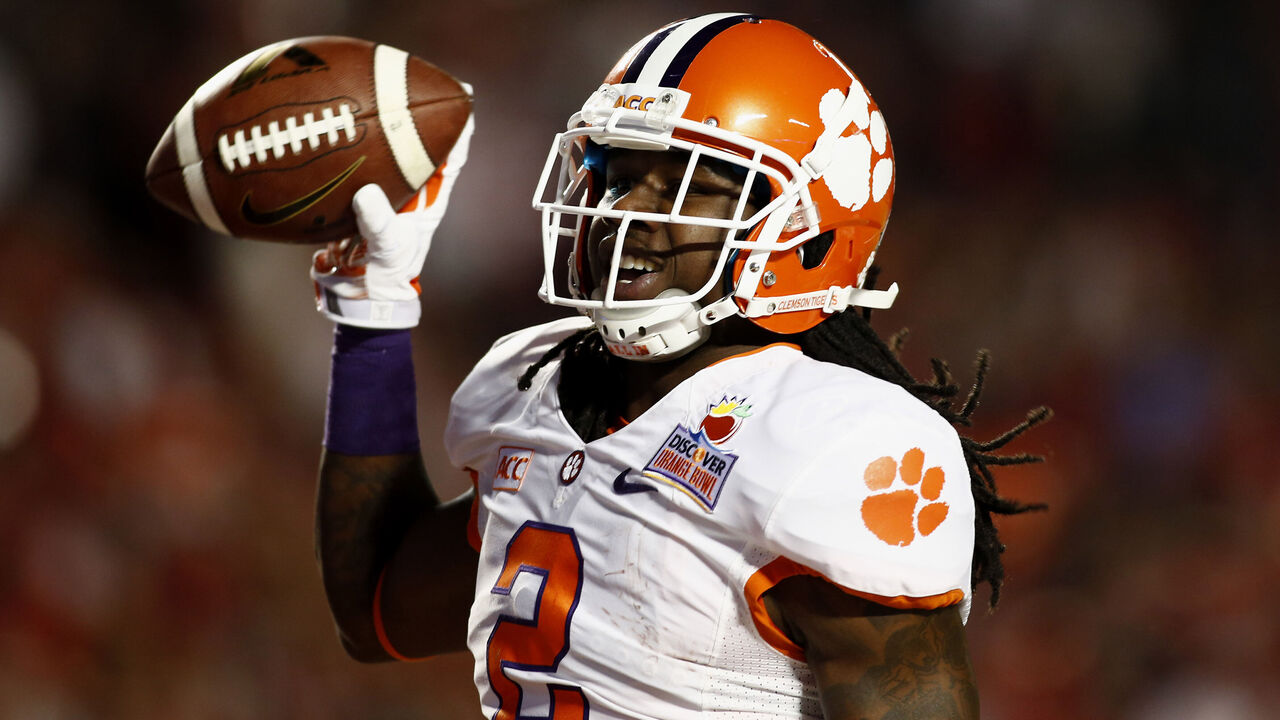
Measurables
- 6'1"
- 211 lbs.
- 4.43 speed
Strengths
Watkins is a speedster and is most dangerous after the catch with the ball in his hands. He can turn a screen or a hitch that looks like it's going to be stuffed into a big play.
His quickness forces defenders into bad angles of pursuit, leading to cutback lanes that Watkins takes advantage of. He has the ability to line up all over the field, including the slot, backfield and, of course, out wide.
Watkins totaled nearly 3,400 yards in college and has the ability to stretch the defense, opening up underneath routes for other receivers and tight ends to make plays. Still, he's effective against zone coverage and knows how to find the open areas and sit down in space.
Weaknesses
Watkins has an average frame and he isn't the ideal receiver for a heavy workload of routes over the middle.
His hands aren't phenomenal and Watkins can drop an easy pass from time to time.
A large chunk of his production at Clemson came from vertical routes and yards after the catch on short pass plays, so it may take Watkins some time to master every pro route in a typical West Coast offense.
NFL player comparison: Torrey Smith
Ideal fit: St. Louis Rams
The Rams would be wise to spend their No. 2 pick on Watkins even though they took Tavon Austin in the top 10 last year. Austin is more of a slot receiver who can be better utilized with Watkins on the outside. That pair would finally give Sam Bradford some legitimate offensive weapons and with St. Louis picking again at 13, the Rams can afford to stock the cupboard early.